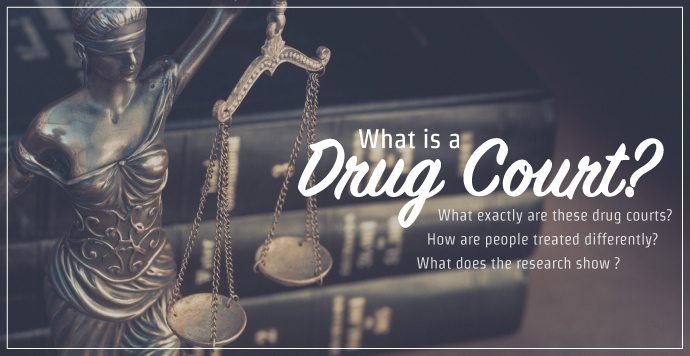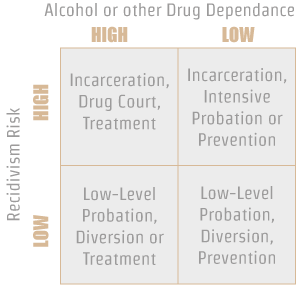What is a Drug Court?

Since their beginnings in 1989, drug courts have appeared in all 50 states. What exactly are these courts? How are people treated differently? What does the research show on how effective they are?
Here’s what we do know.
What is a Drug Court?
In 1989, officials in Miami-Dade County, Florida instituted the nation’s first drug court. The special court was designed to more formally integrate drug treatment into the criminal justice system. The nation was just awakening to the reality of what happens when you address drug abuse through a single approach: Law Enforcement. With as much as 53% of prisoners surveyed in 2004 identifying as having a drug dependence or abuse problem, treatment as a policy also has the potential to show an improvement in outcomes.
The question remains: How would that work?
The Drug Court Model
There are several key aspects of Drug Courts:
- Offender Screening and Assessment of Risks, Needs and Responsivity.
- Judicial Interaction
- Monitoring (drug testing) and Supervision
- Graduated Sanctions and Incentives
- Treatment and Rehabilitation Services
- Relapse Prevention, Aftercare and Community Integration
How Long are People Supervised in Drug Court?
People are typically kept in treatment long enough for it to produce a good chance at recovery, instead of traditional sentences of jail time, and offenders are supervised closely during this time. In most cases, supervision will last for a minimum of one year.
Who Makes up a Drug Court?
Drug Courts are typically made of non-adversarial and multi-disciplinary teams of:
- Judges, Prosecutors
- Defense Attorneys
- Community Corrections
- Social Workers
- Treatment Service Professionals
- Support from Communities, Families and Law Enforcement are encouraged as well.
What are the Typical Steps in the Drug Court Process?
While there are major differences between jurisdictions, the most common aspects of the process are:
- Provides the offender with intensive treatment and other services they require to become sober and maintain recovery.
- Offenders are held accountable by the Drug Court judge in meeting their sentencing obligations to the court, society, themselves and their families.
- Regular and random drug testing to continuously monitor for any illicit drug use.
- Offenders will be required to appear in court frequently, meet with the Drug Court judge and review their progress.
- Rewards are available when the offender does well with their recovery and the overall process, and there are sanctions when they do not live up to their obligations.
Types of and Number of Drug Courts
There are a number of different types of Drug Courts. They vary from each other in the type of offenders that they work with and as well as the types of incentives and punishments they use, community integration methods and judicial restrictions. There is no one size fits all approach to Drug Courts.
Below is a chart showing each type of Drug Court and the number of them as of 2015, the most recent year that statistics are available.
Who is Eligible for Drug Courts?
Narrowing Down the List:
Assessment is the key to understanding if Drug Court is a good option for the offender. While there are a number of different types of Drug Courts in the country, the eligibility to undergo Drug Court varies according to state and local guidelines.
For example, the majority of Drug Courts in the country are adult, criminal Drug Courts, which along with DWI (Driving While Impaired) Courts function within the adult criminal justice system. Family Drug Courts on the other hand work with parents who are facing child abuse/neglect charges in civil court.
Although eligibility requirements vary, most Drug Courts do not consider violent offenders.
Where offenses involve victims, consent of the victim(s) and the payment of restitution are typically mandated.
High Risk Offenders
While there are several classes of offenders that qualify, Drug Courts are specially designed for offenders who are high risk of recidivism and are drug or alcohol dependent.
There are four categories that offenders fall into when being considered for Drug Court, and each inform the process for the type of intervention that the courts will pursue.

Research shows that the impact of Drug Court has the greatest return on investment if the offenders have the following characteristics:
- High-risk of re-offense (e.g., more serious criminal history)
- More serious drug use at intake
- More legal exposure on current case (e.g., jail or prison if terminated) and
- Without co-occurring mental health needs
What the Research Says about the Effectiveness of Drug Courts
While it is generally accepted that Drug Courts effectively reduce rearrest (recidivism) rates when compared to simple probation or incarceration, there is reason to be cautious when interpreting the results from the many studies. Due to differences in evaluation models and a lack of consistent programming among the many Drug Courts, it can be difficult to make sure that the studies are not comparing apples and oranges.
The Research Shows:
- A Government Accountability Office report showed that 13 of the 17 Drug Courts studied reported that the reduction in recidivism post-program ranged from 4-25% as measured by rearrests and reconvictions.
- An evaluation of Drug Courts in Florida and Missouri that tracked Drug Court participant progress for 24 months, found a substantially lower rearrest rate when compared to a comparison group of 12% vs 40% in Florida and 45% vs 65% in Missouri. This is a reduction of rearrest rates of 70% and 31%.
- Researchers found that the 6 Drug Courts studied in New York State saw a 29% reduction in rearrest measured over 3 years following completion of the program.
- Finally, it appears that the effects of the Drug Court program extend beyond the first few years following treatment. The Multnomah County, Oregon Drug Court found a 24% reduction in drug arrests for participants thirteen years after the offender started the program.
There are other factors such as gender, age, race, socioeconomic background, arrest history and substance abuse history that also significantly impact outcomes.
Summary
There were around 1,600 Drug Courts in the US in 2009. We only have data for 2015, but by that time the number of Drug Courts has doubled to 3,142. With 11 distinct types of Drug Courts, there are a variety of different approaches to requirements, incentives and punishments. If you or a loved one is considering a defense through Drug Court, it will be very important to understand how it works in your area.
In an ideal situation, there are teams of people working together in Drug Courts, and this can serve to marshal a lot of resources for people who have come to the attention of the criminal justice system. As a non-adversarial approach, Drug Courts are able to have input from different professionals to bring needed assessment and program help to people who are suffering from a substance use disorder when they are arrested. Some Drug Courts also utilized Medication Assisted Treatment with Buprenorphine combined with residential therapy.
National Institute Of Justice - Drug Courts
National Institute Of Justice - Adult Drug Court Research to Practice (R2P) Initiative
National Association of Drug Court Professionals - How Drug Courts Work
National Association of Drug Court Professionals - NATIONAL DRUG COURT MONTH TOOLKIT



 Resources about addiction and recovery
Resources about addiction and recovery
